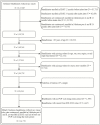Impact of diffuse large B-cell lymphoma on visits to different provider specialties among elderly Medicare beneficiaries: challenges for care coordination
- PMID: 29370438
- PMCID: PMC6257030
- DOI: 10.1093/tbm/ibx071
Impact of diffuse large B-cell lymphoma on visits to different provider specialties among elderly Medicare beneficiaries: challenges for care coordination
Abstract
Newly diagnosed diffuse large B-cell lymphoma (DLBCL) can pose significant challenges to care coordination. We utilized a social-ecological model to understand the impact of DLBCL diagnosis on visits to primary care providers (PCPs) and specialists, a key component of care coordination, over a 3-year period of cancer diagnosis and treatment. We used hurdle models and multivariable logistic regression with the Surveillance Epidemiology and End Result-Medicare linked dataset to analyze visits to PCPs and specialists by DLBCL patients (n = 5,455) compared with noncancer patients (n = 14,770). DLBCL patients were more likely to visit PCPs (adjusted odds ratio, AOR [95% confidence interval, CI]: 1.25 [1.18, 1.31]) and had greater number of visits to PCPs (β, SE: 0.384, -0.014) than noncancer patients. Further, DLBCL patients were more likely to have any visit to cardiologists (AOR [95% CI]: 1.40 [1.32, 1.47]), endocrinologists (1.43, [1.21, 1.70]), and pulmonologists (1.51 [1.36, 1.67]) than noncancer patients. Among DLBCL patients, the number of PCP visits markedly increased during the treatment period compared with the baseline period (β, SE: 0.491, -0.028) and then decreased to baseline levels (-0.464, -0.022). Visits to PCPs and specialists were much more frequent for DLBCL patients than noncancer patients, which drastically increased during the DLBCL treatment period for chronic care. More chronic conditions, treatment side effects, and frequent testing may have increased visits to PCPs and specialists. Interventions to improve care coordination may need to target the DLBCL treatment period, when patients are most vulnerable to poor care coordination.
Figures




Similar articles
-
Venous-thromboembolism and associated health care utilization in elderly patients with diffuse large B cell lymphoma.Cancer. 2022 Jun 15;128(12):2348-2357. doi: 10.1002/cncr.34210. Epub 2022 Apr 1. Cancer. 2022. PMID: 35363373 Free PMC article.
-
Oncologist volume and outcomes in older adults diagnosed with diffuse large B cell lymphoma.Cancer. 2018 Nov 1;124(21):4211-4220. doi: 10.1002/cncr.31688. Epub 2018 Sep 14. Cancer. 2018. PMID: 30216436 Free PMC article.
-
Changes in Health Care Use and Outcomes After Turnover in Primary Care.JAMA Intern Med. 2021 Feb 1;181(2):186-194. doi: 10.1001/jamainternmed.2020.6288. JAMA Intern Med. 2021. PMID: 33196767 Free PMC article.
-
Association of Preexisting Heart Failure With Outcomes in Older Patients With Diffuse Large B-Cell Lymphoma.JAMA Cardiol. 2023 May 1;8(5):453-461. doi: 10.1001/jamacardio.2023.0303. JAMA Cardiol. 2023. PMID: 36988926 Free PMC article.
-
Diffuse large B-cell lymphoma.Crit Rev Oncol Hematol. 2013 Aug;87(2):146-71. doi: 10.1016/j.critrevonc.2012.12.009. Epub 2013 Jan 30. Crit Rev Oncol Hematol. 2013. PMID: 23375551 Review.
Cited by
-
Impact of COVID-19 related movement restrictions on the follow-up care visits of adults with chronic conditions: A Saudi arabian survey study.Saudi Pharm J. 2023 Dec;31(12):101846. doi: 10.1016/j.jsps.2023.101846. Epub 2023 Oct 26. Saudi Pharm J. 2023. PMID: 38033751 Free PMC article.
-
Healthcare utilization and spending among older patients diagnosed with Non-Hodgkin lymphoma.J Geriatr Oncol. 2021 Nov;12(8):1225-1232. doi: 10.1016/j.jgo.2021.06.006. Epub 2021 Jun 25. J Geriatr Oncol. 2021. PMID: 34176753 Free PMC article.
References
-
- National Cancer Institute. Surveillance, Epidemiology, and End Results program. SEER Stat Fact Sheets: Non-Hodgkin lymphoma Available at http://seer.cancer.gov/statfacts/html/nhl.html. Accessibility verified June 9, 2016.
-
- Shankland KR, Armitage JO, Hancock BW. Non-Hodgkin lymphoma. Lancet. 2012;380(9844):848–857. - PubMed
-
- Teras LR, DeSantis CE, Cerhan JR, Morton LM, Jemal A, Flowers CR. 2016 US lymphoid malignancy statistics by World Health Organization subtypes. CA Cancer J Clin. 2016;66(6):443–459. - PubMed
-
- Pirani M, Marcheselli R, Marcheselli L, Bari A, Federico M, Sacchi S. Risk for second malignancies in non-Hodgkin’s lymphoma survivors: a meta-analysis. Ann Oncol. 2011;22(8):1845–1858. - PubMed
MeSH terms
Grants and funding
LinkOut - more resources
Full Text Sources
Other Literature Sources
Medical

